Capacity Analysis of Hybrid Satellite–Terrestrial Systems with Selection Relaying
Abstract
:1. Introduction
1.1. Related Work
1.2. Contribution and Organization
- We propose a model of the satellite–terrestrial communication system, where the transmitted signal at the relay depends on the result of the comparison of the received SNR with the arbitrary local threshold;
- In this paper, we derive the novel analytical expressions for the outage probability for the arbitrary threshold at the relay, which can be different from the threshold at the destination, extending our previous results published in [34], which were based on more general probability density functions. Additionally, we derive novel expressions for the outage capacity and ergodic capacity, providing the corresponding numerical results;
- We derive the analytical expressions for the probability density function of the received SNR at the destination for the given threshold at the relay;
- We derive the analytical expressions for the outage capacity of the system, which is a relevant performance measure for applications with delay constraints;
- We derive the relevant analytical expressions for the ergodic capacity of the analyzed system for applications with no delay requirements;
- All analytical expressions derived in the paper are given in polynomial–exponential form, and they are valid for the general case of the shadowed Rice fading environment with the integer-valued fading parameter at the satellite–terrestrial links and Nakagami-m fading environment at the terrestrial link;
- The derived expressions are general and applicable to a transmission system with arbitrary system parameters;
- We propose a novel method for generating the time series that corresponds to the time-varying channel gains in satellite–terrestrial links as an improved version of the simulation method that we proposed in [35]. In this paper, we use an improved simulation method that includes the terrestrial component, deriving the corresponding temporal autocorrelation function of the complex channel gain in the satellite–terrestrial link;
- Analytical results are confirmed using an independent Monte Carlo simulation method, and the corresponding numerical results are presented for the various propagation scenarios and typical parameters of the active LEO satellite systems.
2. System and Channel Model
- In the first half of the signalization interval, the source sends a signal to the receivers at the destination and at the relay. The instantaneous received SNR in the S-D link in an arbitrary time instant t is denoted by γ1(t), and the instantaneous received SNR in the S-R link is denoted by γ2(t).
- After the first half of the signalization interval, the relay performs decoding. If the decoding is successful, in the second half of the signalization interval, the receiver at the destination receives the signal from the relay, with the instantaneously received SNR in the R-D link being denoted by γ3(t). Otherwise, the relay is silent (it does not send any signal). The decoding at the relay is usually considered successful in the time instant t if the received SNR is larger than the predefined threshold, denoted by γth,R [14]. The value of the threshold depends on the applied modulation and coding scheme at the corresponding communication link, as well as the receiver sensitivity.
- The signals received in the first and the second half of the signalization interval are combined. In this paper, we assume that MRC is applied at the destination receiver. Therefore, the SNR at the output of the MRC combiner is obtained as the sum of the SNRs in two intervals [33] as follows:
- A.
- Satellite–terrestrial channel
- B.
- Channel model in terrestrial links
3. Outage Capacity
- In the case when γth,R→∞, we obtain I2→1, I3→0, and the resulting outage probability corresponds to the case without relaying (when only S-D link is present).
- 2.
- In the case when γth,R→0 (the reliable S-R link), the instantaneous SNR is obtained as , we obtain I2→0, I3→1, and the resulting outage probability is determined with the expression of I4, i.e.,
- In the case when powerful error correction codes are applied in all communication links, the above expression is a good approximation in the region of very small values for γth.
- 3.
- In the case when γth,R = γth, the derived outage probability reduced to the expression derived in our conference paper [34].
- 1.
- The analysis for the fixed relaying DF protocol, where it is assumed that the relay retransmits signal even in the case when the instantaneous SNR at the relay is below the threshold, i.e., the outage appears at the destination whenever , i.e.,
- Finally, the closed form expression is easily obtained from Equation (32) if the first and third summation (the second and the fourth term) are ignored. This solution represents the closed form solution for the analysis given in [33].
- 2.
- The analysis for the simple DF protocol, where it is assumed that the S-D link is blocked [21], can be obtained if we set = 0, and therefore
- The outage probability is derived through setting , where denotes the delta function, and it can be determined using the simplified expression as follows:
4. Ergodic Capacity
5. Numerical Results
- We apply the method based on autoregressive models [53] to generate the time series x(n) that describes the multipath component. It corresponds to the complex Gaussian random process with a Rayleigh distributed envelope. In the case of isotropic scattering, the normalized autocorrelation function is given by , where fDm denotes the maximum Doppler shift for the multipath component (we assume fDm = 100 Hz).
- The first step is repeated to generate a time series y(n), independent from x(n), with the Rayleigh distributed envelope and ACF , where fDs denotes the maximum Doppler shift for the shadowing (which is usually fDs << fDm, while in our simulations, we chose fDs = 1 Hz [54]).
- Based on the rejection/acceptance technique described in [55,56], we have generated a temporally uncorrelated time series zun1(n) with Nakagami distribution. The rank matching method described in [47] is applied to reorder the samples in that process according to the previously generated reference y(n). The resulting time series z(n) corresponds to the time-varying LOS component that has an envelope with Nakagami distribution (as in zun1(n)) and a normalized ACF (as in y(n)).
- Two previous steps are repeated to generate w(n) with a Rayleigh distributed envelope and the maximum Doppler shift fDt. It was combined with the temporally uncorrelated time series zun2(n), resulting in the time series h3(n) with a Nakagami distributed envelope and a normalized ACF, where . This corresponds to the channel gain of the terrestrial R-D link.
- Channel gains for any satellite–terrestrial link (S-D or S-R) are obtained through the expression h(n) = x(n) + w(n).
- -
- simple DF protocol, for the case where the S-D link is blocked, as a typical scenario for HSTRNs, previously analyzed in [21];
- -
- fixed relaying protocol, i.e., the DF protocol applied for the case where the S-D link is present, the relay always retransmits the signal, and MRC is applied at the destination was analyzed in [33];
- -
- -
- γth,R = γth, as assumed in most of the papers;
- -
- value γth,R is fixed, and Pout is given for a typical range of γD.
6. Conclusions
Author Contributions
Funding
Institutional Review Board Statement
Informed Consent Statement
Data Availability Statement
Conflicts of Interest
Appendix A
References
- Dahlman, E.; Parkvall, S.J.; Skold, J. 5G NR: The Next Generation Wireless Access Technology, 2nd ed.; Academic Press: Cambridge, MA, USA, 2020. [Google Scholar]
- 3rd Generation Partnership Project. TR 38.821. Solutions for NR to Support Non-Terrestrial Networks. (NTN), V16.0.0, January 2020. Available online: https://atisorg.s3.amazonaws.com/archive/3gpp-documents/Rel16/ATIS.3GPP.38.821.V1600.pdf (accessed on 15 February 2024).
- Darwish, T.; Kurt, G.K.; Yanikomeroglu, H.; Bellemare, M.; Lamontagne, G. LEO satellites in 5G and beyond networks: A review from a standardization perspective. IEEE Access 2022, 10, 35040–35060. [Google Scholar] [CrossRef]
- Kodheli, O.; Lagunas, E.; Maturo, N.S.; Sharma, K.; Shankar, B.; Montoya, J.F.M.; Duncan, J.C.M.; Spano, D.; Chatzinotas, S.; Kisseleff, S.; et al. Satellite communications in the new space era: A survey and future challenges. IEEE Commun. Surv. Tutor. 2021, 23, 70–109. [Google Scholar] [CrossRef]
- Del Portillo, I.; Cameron, B.G.; Crawley, E.F. A technical comparison of three low earth orbit satellite constellation systems to provide global broadband. Acta Astronaut. 2019, 159, 123–135. [Google Scholar] [CrossRef]
- Maral, G.; Bousquet, M.; Sun, Z. Satellite Communications Systems: Systems, Techniques and Technology, 6th ed.; John Wiley & Sons Ltd.: Boca Raton, FL, USA, 2020. [Google Scholar]
- Gongora-Torres, J.M.; Vargas-Rosales, C.; Aragón-Zavala, A.; Villalpando-Hernandez, R. Elevation Angle Characterization for LEO Satellites: First and Second Order Statistics. Appl. Sci. 2023, 13, 4405. [Google Scholar] [CrossRef]
- Zhou, H.; Liu, L.; Ma, H. Coverage and Capacity Analysis of LEO Satellite Network Supporting Internet of Things. In Proceedings of the 2019 IEEE International Conference on Communications (ICC 2019), Shanghai, China, 20–24 May 2019; pp. 1–6. [Google Scholar] [CrossRef]
- Liu, F.; Qian, G. Simulation Analysis of Network Capacity for LEO Satellite. In Proceedings of the 2020 International Conference on Computer Science and Management Technology (ICCSMT 2020), Shanghai, China, 20–22 November 2020; pp. 100–104. [Google Scholar] [CrossRef]
- Deng, R.; Di, B.; Zhang, H.; Kuang, L.; Song, L. Ultra-Dense LEO Satellite Constellations: How Many LEO Satellites Do We Need? IEEE Trans. Wirel. Commun. 2021, 20, 4843–4857. [Google Scholar] [CrossRef]
- Rozenvasser, D.; Shulakova, K. Estimation of the Starlink Global Satellite System Capacity. In Proceedings of the 12th International Conference on Applied Innovation in IT (ICAIIT 2024), Kothen, Germany, 9 March 2023; pp. 55–59. [Google Scholar] [CrossRef]
- Abdi, A.; Lau, W.C.; Alouini, M.-S.; Kaveh, M. A new simple model for land mobile satellite channels: First- and second-order statistics. IEEE Trans. Wirel. Commun 2003, 2, 519–528. [Google Scholar] [CrossRef]
- Sendonaris, A.; Erkip, E.; Aazhang, B. User cooperation diversity. Part, I. System description. IEEE Trans. Commun. 2003, 51, 1927–1938. [Google Scholar] [CrossRef]
- Laneman, J.N.; Tse, D.N.C.; Wornell, G.W. Cooperative diversity in wireless networks: Efficient protocols and outage behavior. IEEE Trans. Inf. Theory 2004, 50, 3062–3080. [Google Scholar] [CrossRef]
- Yu, M.; Li, J. Is amplify-and-forward practically better than decode-and-forward or vice versa? In Proceedings of the IEEE International Conference on Acoustics, Speech, and Signal Processing (ICASSP 2005), Philadelphia, PA, USA, 23 March 2005; Volume 3, pp. iii/365–iii/368. [Google Scholar] [CrossRef]
- Siriwongpairat, W.P.; Himsoon, T.; Su, W.; Liu, K.J.R. Optimum threshold-selection relaying for decode-and-forward cooperation protocol. In Proceedings of the IEEE Wireless Communications and Networking Conference (WCNC 2006), Las Vegas, NV, USA, 3–6 April 2006; pp. 1015–1020. [Google Scholar] [CrossRef]
- Evans, B.; Werner, M.; Lutz, E.; Bousquet, M.; Corazza, G.; Maral, G.; Rumeau, R. Integration of satellite and terrestrial systems in future multimedia communications. IEEE Trans. Wirel. Commun. 2005, 12, 72–80. [Google Scholar] [CrossRef]
- Bhatnagar, M.R.; Arti, M.K. Performance analysis of AF based hybrid satellite-terrestrial cooperative network over generalize fading channels. IEEE Commun. Lett. 2013, 17, 1912–1915. [Google Scholar] [CrossRef]
- Arti, M.K.; Bhatnagar, M.R. Beamforming and combining in hybrid satellite-terrestrial cooperative systems. IEEE Commun. Lett. 2014, 18, 483–486. [Google Scholar] [CrossRef]
- An, K.; Lin, M.; Liang, T.; Wang, J.B.; Wang, J.; Huang, Y.; Swindlehurst, A.L. Performance Analysis of Multi-Antenna Hybrid Satellite-Terrestrial Relay Networks in the Presence of Interference. IEEE Trans. Commun. 2015, 63, 4390–4404. [Google Scholar] [CrossRef]
- An, K.; Liang, T. Hybrid satellite-terrestrial relay networks with adaptive transmission. Trans. Veh. Technol. 2019, 68, 12448–12452. [Google Scholar] [CrossRef]
- Guo, K.; Lin, M.; Zhang, B.; Wang, J.-B.; Wu, Y.; Zhu, W.-P.; Cheng, J. Performance Analysis of Hybrid Satellite-Terrestrial Cooperative Networks with Relay Selection. IEEE Trans. Veh. Technol. 2020, 69, 9053–9067. [Google Scholar] [CrossRef]
- Ding, Y.; Zou, Y.; Li, B. Ergodic Capacity and Outage Probability Analysis of RIS-Aided Hybrid Satellite-Terrestrial Networks. In Proceedings of the 14th International Conference on Wireless Communications and Signal Processing (WCSP 2022), Nanjing, China, 1–3 November 2022; pp. 837–841. [Google Scholar] [CrossRef]
- Bankey, V.; Upadhyay, P.K. Ergodic capacity of multiuser hybrid satellite-terrestrial fixed-gain AF relay networks with CCI and outdated CSI. IEEE Trans. Veh. Technol. 2018, 67, 4666–4671. [Google Scholar] [CrossRef]
- Akhmetkaziyev, Y.; Nauryzbayev, G.; Arzykulov, S.; Rabie, K.; Eltawil, A. Ergodic Capacity of Cognitive Satellite-Terrestrial Relay Networks with Practical Limitations. In Proceedings of the International Conference on Information and Communication Technology Convergence (ICTC 2021), Jeju Island, Republic of Korea, 20–22 October 2021; pp. 555–560. [Google Scholar] [CrossRef]
- Lin, H.; Zhang, C.; Huang, Y.; Zhao, R.; Yang, L. Downlink Outage Analysis of Integrated Satellite-Terrestrial Relay Network with Relay Selection and Outdated CSI. In Proceedings of the 93rd IEEE Vehicular Technology Conference (VTC2021-Spring), Helsinki, Finland, 25–28 April 2021. [Google Scholar] [CrossRef]
- Zhang, H.; Pan, G.; Ke, S.; Wang, S.; An, J. Outage Analysis of Cooperative Satellite-Aerial-Terrestrial Networks with Spatially Random Terminals. IEEE Trans. Commun. 2022, 70, 4972–4987. [Google Scholar] [CrossRef]
- Pan, G.; Ye, J.; An, J.; Alouini, S. Latency versus Reliability in LEO Mega-Constellations: Terrestrial, Aerial, or Space Relay. IEEE Trans. Mobile Comput. 2023, 22, 5330–5345. [Google Scholar] [CrossRef]
- Lin, Z.; Lin, M.; Champagne, B.; Zhu, W.-P.; Al-Dhahir, N. Secrecy-Energy Efficient Hybrid Beamforming for Satellite-Terrestrial Integrated Networks. IEEE Trans. Commun. 2021, 69, 6345–6360. [Google Scholar] [CrossRef]
- Lin, Z.; Lin, M.; de Cola, T.; Wang, J.-B.; Zhu, W.-P.; Cheng, J. Supporting IoT with Rate-Splitting Multiple Access in Satellite and Aerial-Integrated Networks. IEEE Internet Things J. 2021, 8, 11123–11134. [Google Scholar] [CrossRef]
- Lin, Z.; Lin, M.; Wang, J.-B.; de Cola, T.; Wang, J. Joint Beamforming and Power Allocation for Satellite-Terrestrial Integrated Networks with Non-Orthogonal Multiple Access. IEEE J. Sel. Top. Signal Process. 2019, 13, 657–670. [Google Scholar] [CrossRef]
- Lin, Z.; Lin, M.; Champagne, B.; Zhu, W.-P.; Al-Dhahir, N. Secure and Energy Efficient Transmission for RSMA-Based Cognitive Satellite-Terrestrial Networks. IEEE Wirel. Commun. Lett. 2021, 10, 251–255. [Google Scholar] [CrossRef]
- Sakarellos, V.K.; Kourogiorgas, C.; Panagopolous, A.D. Cooperative hybrid land mobile satellite-terrestrial broadcasting systems: Outage probability evaluation and accurate simulation. Wirel. Pers. Commun. 2014, 79, 1471–1481. [Google Scholar] [CrossRef]
- Milojković, J.; Ivaniš, P.; Blagojević, V.; Brkić, S. Performance analysis of land mobile satellite-terrestrial systems with selection relaying. In Proceedings of the 10th International Conference on Electrical, Electronic and Computing Engineering (IcETRAN 2023), TEI 1.2, East Sarajevo, Bosnia and Herzegovina, 5–8 June 2023. [Google Scholar] [CrossRef]
- Ivaniš, P.; Blagojević, V.; Đorđević, G. The method of generating shadowed Rice fading with desired statistical properties. In Proceedings of the 22nd International Symposium INFOTEH-JAHORINA (INFOTEH 2023), Jahorina, Bosnia and Herzegovina, 15–17 March 2023. [Google Scholar] [CrossRef]
- Ye, J.; Pan, G.; Alouini, M.-S. Earth Rotation-Aware Non-Stationary Satellite Communication Systems: Modeling and Analysis. IEEE Trans. Wirel. Commun. 2021, 20, 5942–5956. [Google Scholar] [CrossRef]
- Lutz, E. Modelling of the land mobile satellite communications channel. In Proceedings of the IEEE-APS Topical Conference on Antennas and Propagation in Wireless Communications (APWC 2013), Turin, Italy, 9–13 September 2013; pp. 199–202. [Google Scholar] [CrossRef]
- Loo, C. A statistical model for a land mobile satellite link. IEEE Trans. Veh. Technol. 1985, 34, 122–127. [Google Scholar] [CrossRef]
- Abdi, A.; Lau, W.C.; Alouini, M.-S.; Kaveh, M. On the second-order statistics of a new simple model for land mobile satellite channels. In Proceedings of the 54th Vehicular Technology Conference (VTC Fall 2001), Atlantic City, NJ, USA, 7–11 October 2001; Volume 1, pp. 301–304. [Google Scholar] [CrossRef]
- Clarke, R.H. A Statistical Theory of Mobile Radio Reception. Bell Syst. Tech. J. 1968, 47, 957–1000. [Google Scholar] [CrossRef]
- Jakes, W.C. Microwave Mobile Communications, 2nd ed.; IEEE Press: New York, NY, USA, 1993. [Google Scholar]
- Ivanis, P.; Drajic, D.; Vucetic, B. The second order statistics of maximal ratio combining with unbalanced branches. IEEE Commun. Lett. 2008, 12, 508–510. [Google Scholar] [CrossRef]
- Ivanis, P.; Blagojevic, V.; Drajic, D.; Vucetic, B. Closed-Form Level Crossing Rates Expressions of Orthogonalized Correlated MIMO Channels. IEEE Trans. Veh. Technol. 2011, 60, 1910–1916. [Google Scholar] [CrossRef]
- Ivanis, P.; Blagojevic, V.; Drajic, D.; Vucetic, B. Second Order Statistics of a Maximum Ratio Combiner with Unbalanced and Unequally Distributed Nakagami Branches. IET Commun. 2011, 5, 1829–1835. [Google Scholar] [CrossRef]
- Yacoub, M.D.; Bautista, J.E.V.; Guerra de Rezende Guedes, L. On higher order statistics of the Nakagami-m distribution. IEEE Trans. Veh. Technol. 1999, 48, 790–794. [Google Scholar] [CrossRef]
- Abramowitz, M.; Stegun, I.A. Handbook of Mathematical Functions with Formulas, Graphs, and Mathematical Tables; Dover: New York, NY, USA, 1972. [Google Scholar]
- Silveira Santos Filho, J.C.; Yacoub, M.D.; Fraidenraich, G. A Simple Accurate Method for Generating Autocorrelated Nakagami-m Envelope Sequences. IEEE Commun. Lett. 2007, 11, 231–233. [Google Scholar] [CrossRef]
- Sakarellos, V.K.; Skraparlis, D.; Panagopoulos, A.D.; Kanellopoulos, J.D. Cooperative diversity performance of selection relaying over correlated shadowing. Phys. Commun. 2011, 4, 182–189. [Google Scholar] [CrossRef]
- Goldsmith, A. Wireless Communications; Cambridge University Press: Cambridge, UK, 2005. [Google Scholar]
- Thakur, S.; Singh, A. Ergodic Secrecy Capacity in Nakagami-m Fading Channels. In Proceedings of the International Carnahan Conference on Security Technology (ICCST 2019), Chennai, India, 1–3 October 2019. [Google Scholar] [CrossRef]
- Available online: https://functions.wolfram.com/ (accessed on 20 January 2024).
- Matolak, D.W.; Zhang, Q.; Wu, Q. Path Loss in an Urban Peer-to-Peer Channel for Six Public-Safety Frequency Bands. IEEE Wirel. Commun. Lett. 2013, 2, 263–266. [Google Scholar] [CrossRef]
- Baddour, K.E.; Beaulieu, N.C. Autoregressive modeling for fading channel simulation. IEEE Trans. Wireless Commun. 2005, 4, 1650–1662. [Google Scholar] [CrossRef]
- Vucetic, B.; Du, J. Channel modeling and simulation in satellite mobile communication systems. IEEE J. Sel. Areas Commun. 1992, 10, 1209–1218. [Google Scholar] [CrossRef]
- Papoulis, A.; Pillai, S.U. Probability Random Variables and Stochastic Processes, 4th ed.; McGraw-Hill: Boston, MA, USA, 2002. [Google Scholar]
- Zhu, Q.-M.; Yu, X.-B.; Wang, J.-B.; Xu, D.-Z.; Chen, X.-M. A new generation method for spatial-temporal correlated MIMO Nakagami fading channel. Int. J. Antennas Propag. 2012, 2012, 713594. [Google Scholar] [CrossRef]
- Ikki, S.; Ahmed, M.H. Performance of Decode-and-Forward Cooperative Diversity Networks Over Nakagami-m Fading Channels. In Proceedings of the IEEE Global Telecommunications Conference (GLOBECOM 2007), Washington, DC, USA, 26–30 November 2007; pp. 4328–4333. [Google Scholar] [CrossRef]
- Jeruchim, M.C.; Balaban, P.; Shanmugan, K.S. Simulation of Communication Systems: Modeling, Methodology and Techniques; Springer Science & Business Media: Berlin, Germany, 2006. [Google Scholar]
- Milojković, J.; Brkić, S.; Ivaniš, P.; Čiča, Z. Performance of Handover Execution in Satellite Networks with Shadowed-Rician Fading. In Proceedings of the 16th International Conference on Advanced Technologies, Systems and Services in Telecommunications (TELSIKS 2023), Niš, Serbia, 25–27 October 2023; pp. 155–158. [Google Scholar] [CrossRef]
- Gradshteyn, I.S.; Ryzhik, I.M. Table of Integrals, Series and Products, 5th ed.; Academic Press Inc.: San Diego, CA, USA, 1994. [Google Scholar]
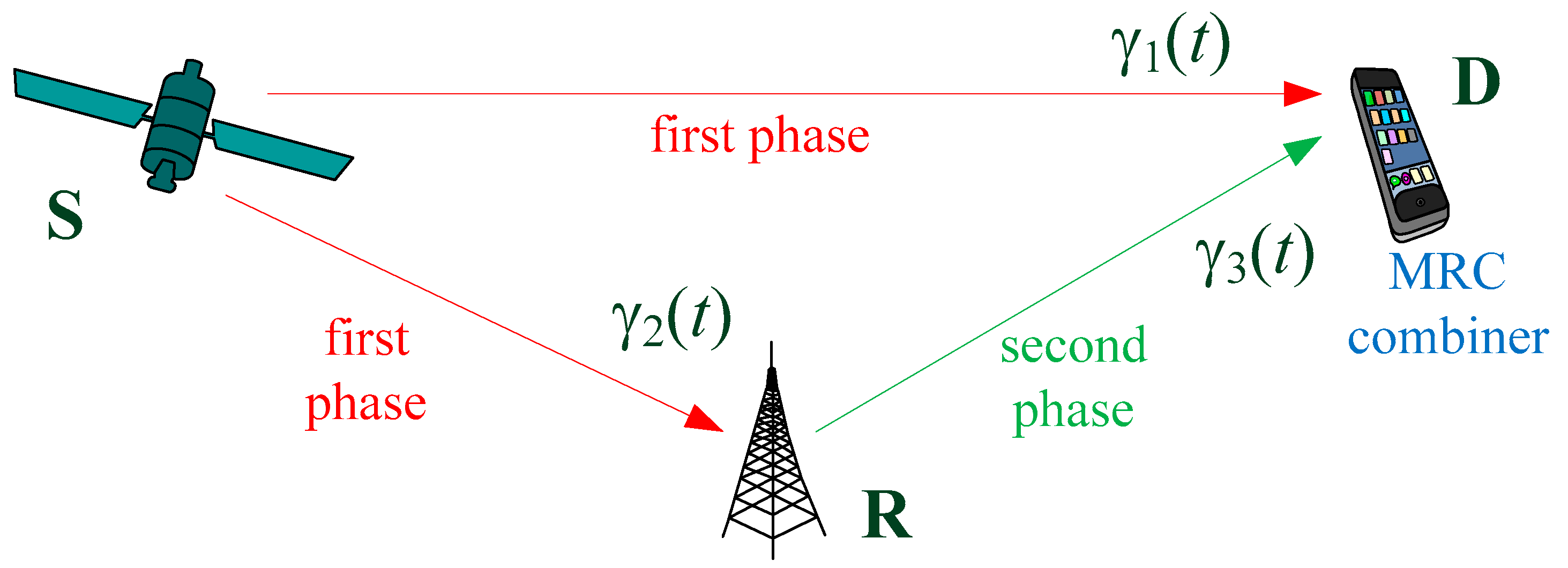

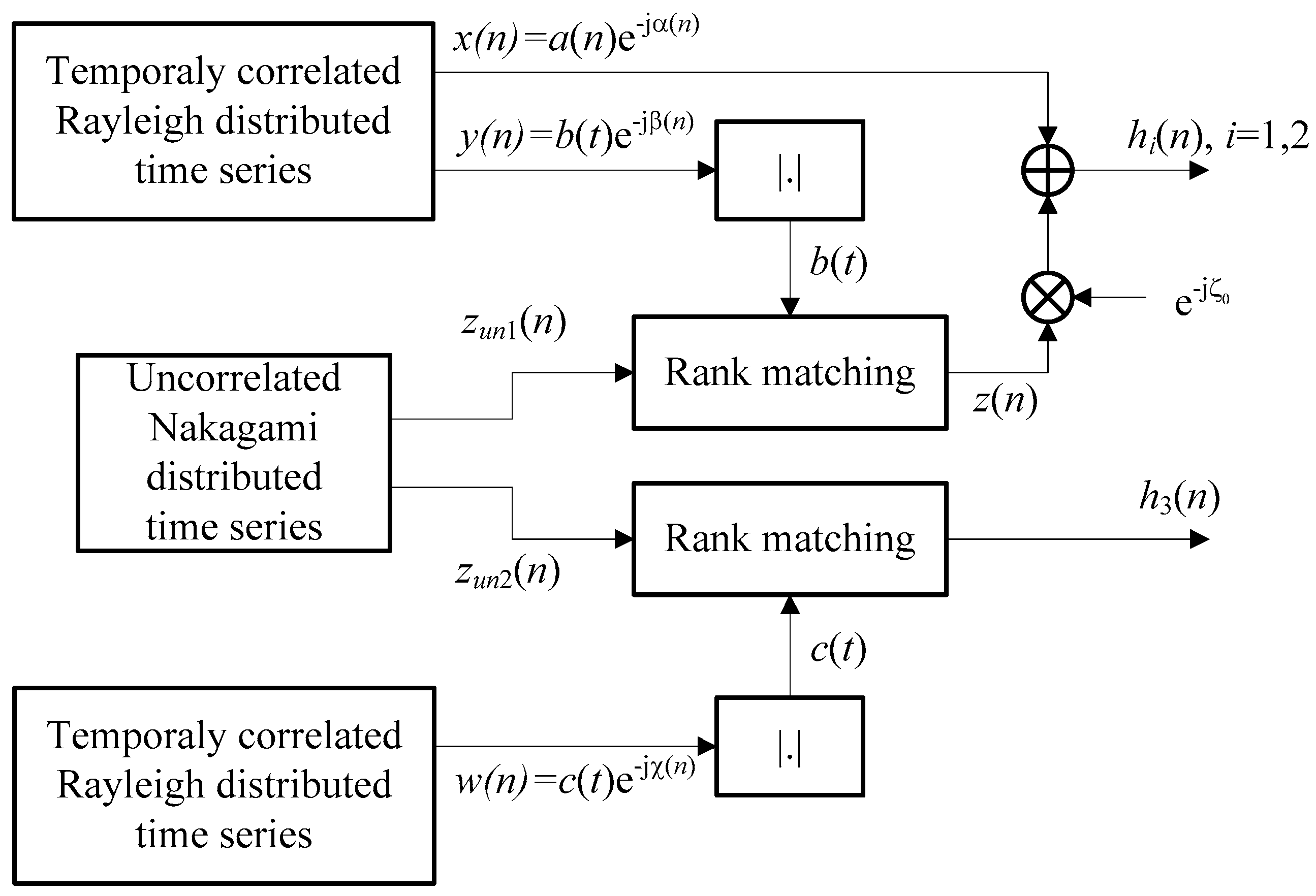
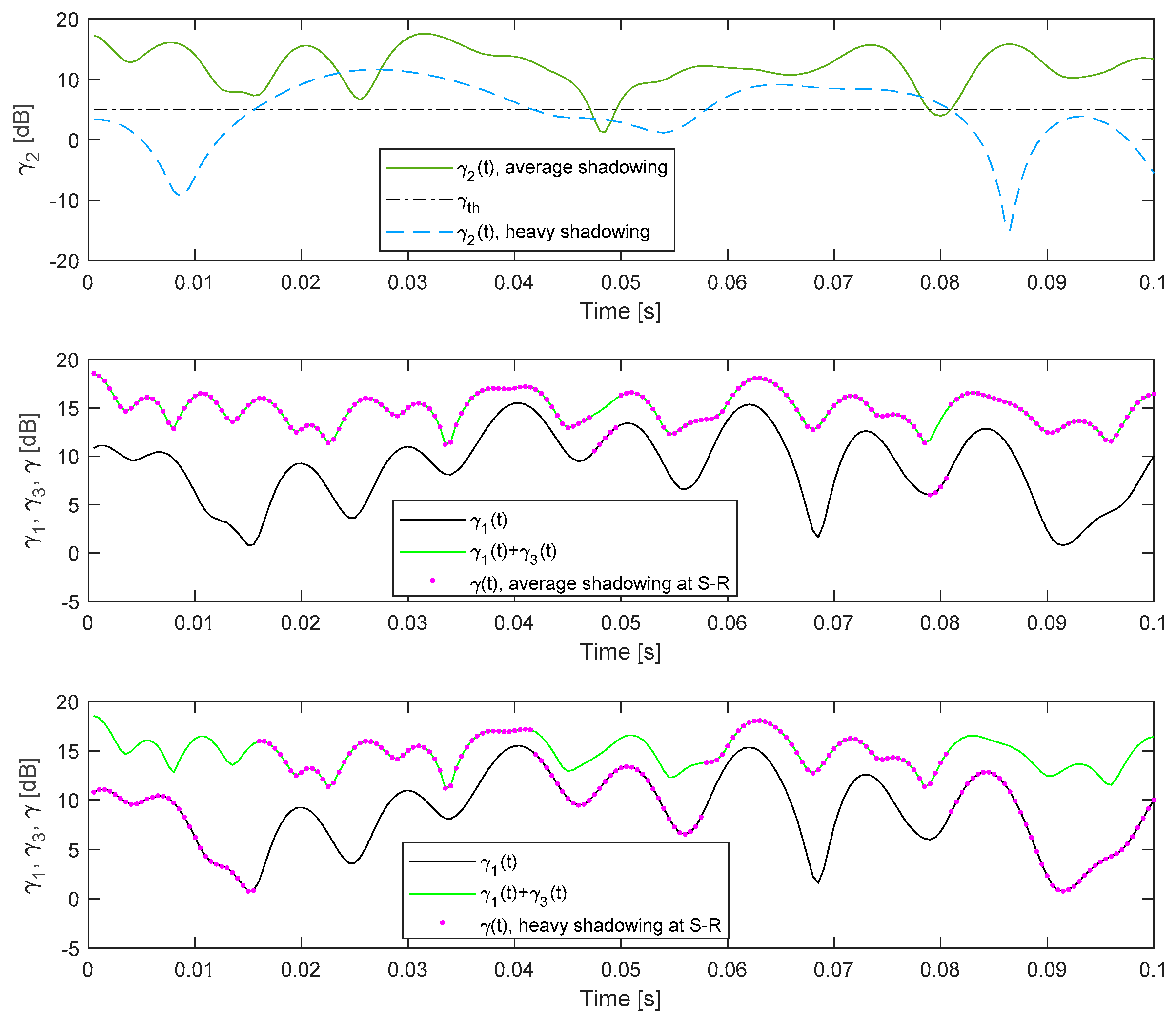
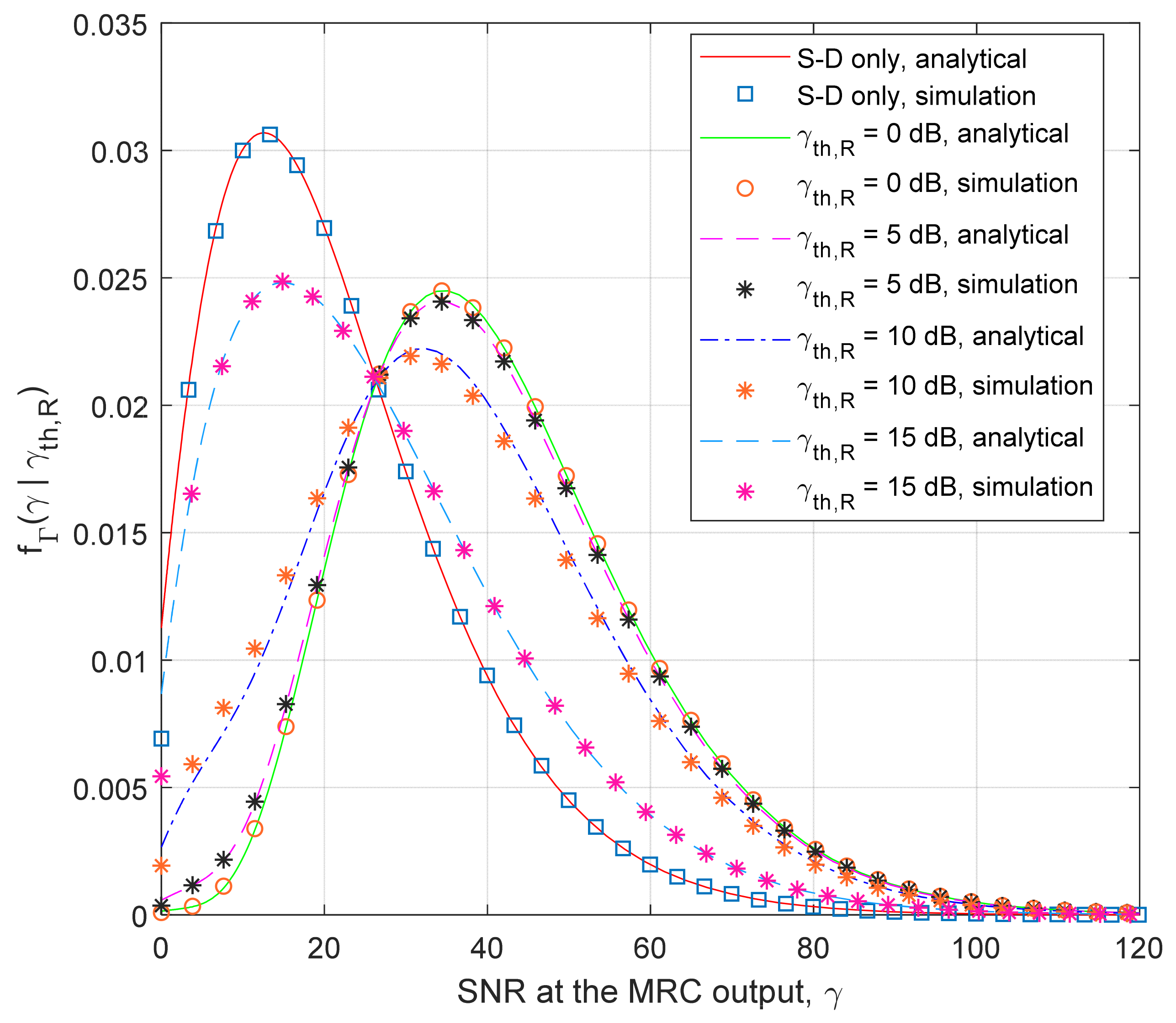






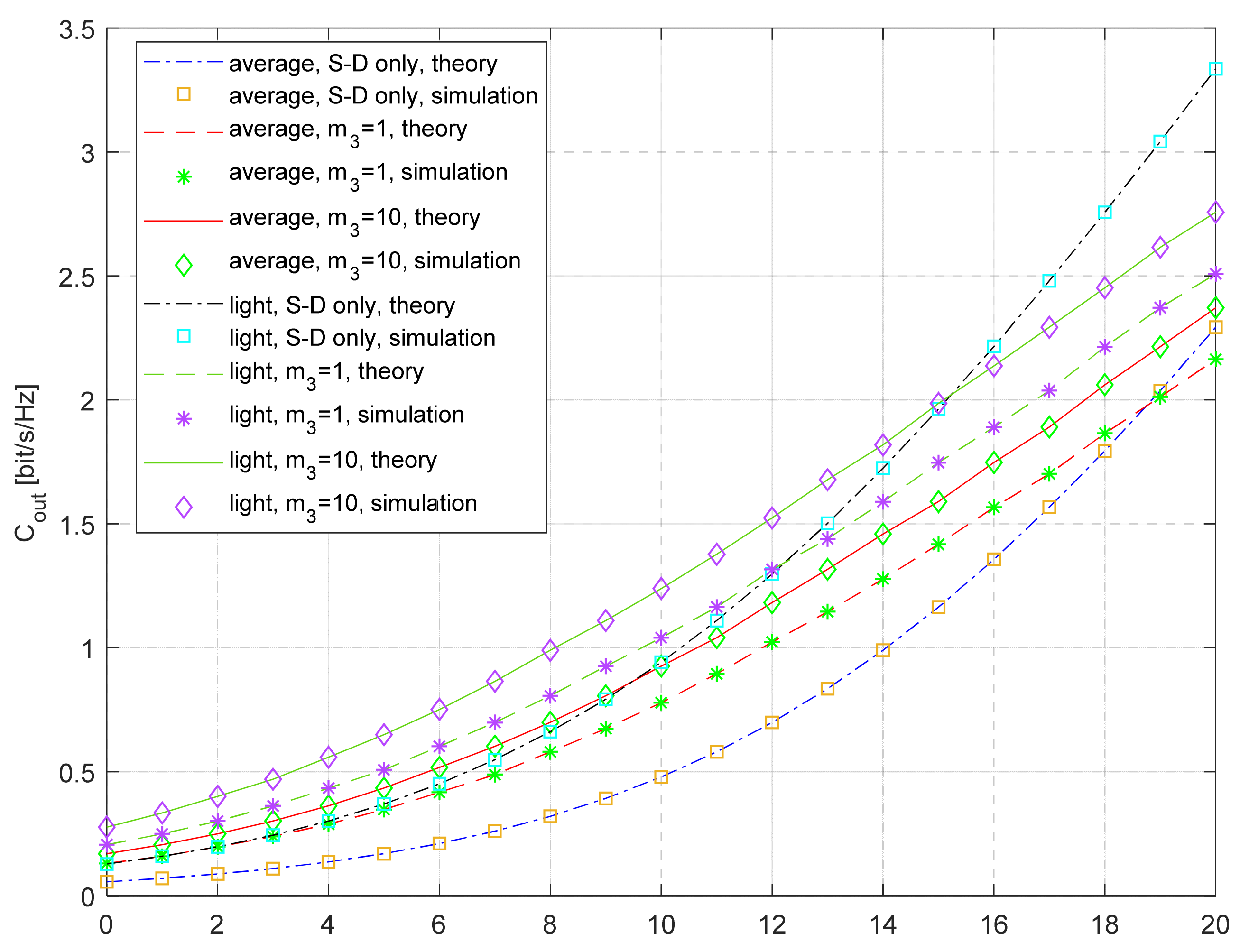
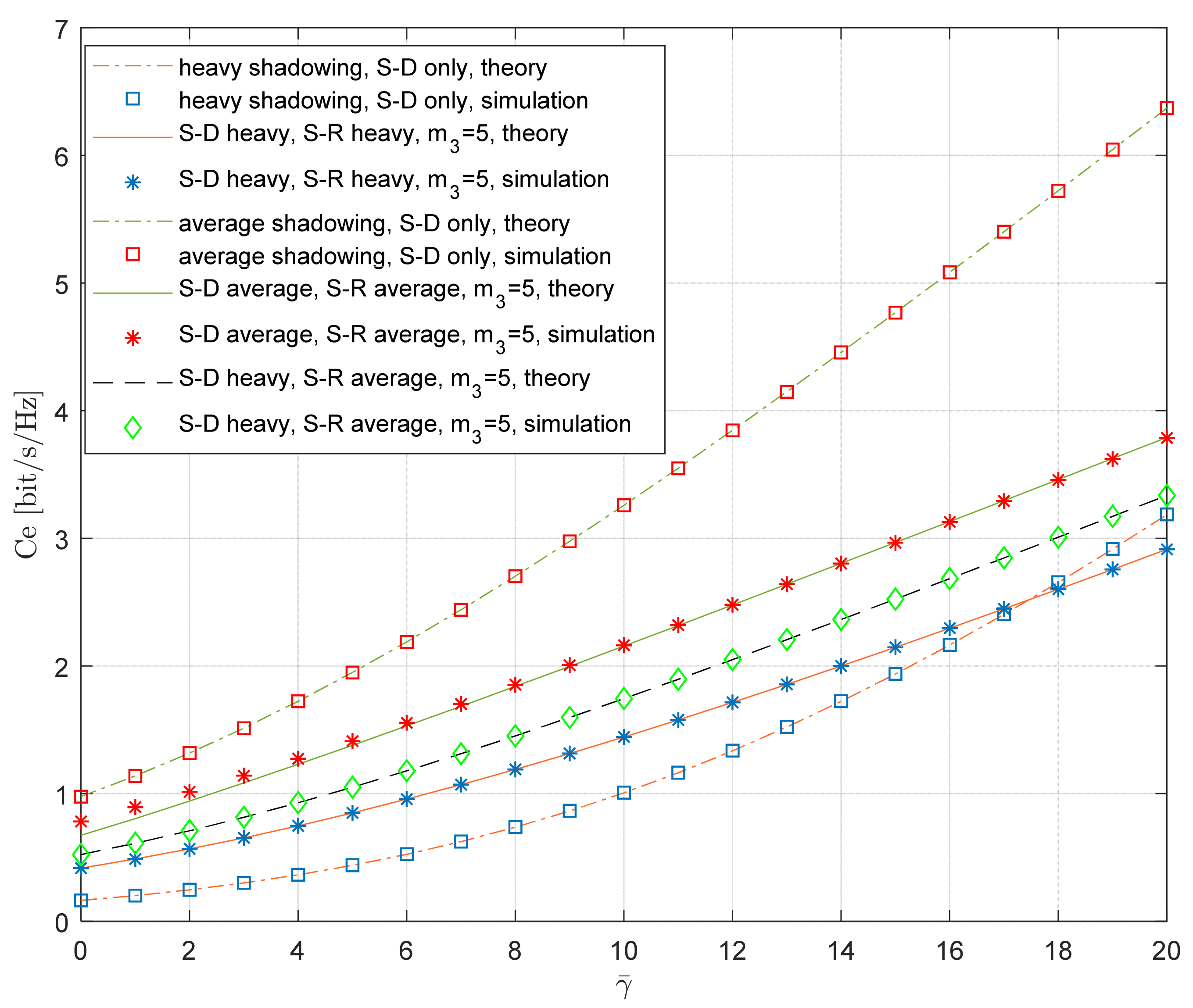

| Symbol | Explanation |
|---|---|
| PS | the power of the signal from the satellite |
| PR | the power the signal from the relay |
| h1 | the complex channel gain between the satellite (S) and destination (D) |
| h2 | the complex channel gain between the satellite (S) and relay (R) |
| h3 | the complex channel gain between the relay (R) and destination (D) |
| γ1 | the instantaneous SNR at the output of the S-D link |
| γ2 | the instantaneous SNR at the output of the S-R link |
| γ3 | the instantaneous SNR at the output of the R-D link |
| γ | the instantaneous SNR at the output of the MRC combiner at the destination |
| γth | the threshold at the destination |
| γth,R | the threshold at the relay |
| dSD | the distance between the satellite and destination |
| dSR | the distance between the satellite and relay |
| dRD | the distance between the relay and destination |
| nSD | the path loss between the satellite and destination |
| nSR | the path loss between the satellite and relay |
| nRD | the path loss between the relay and destination |
| θ | elevation |
| σ2 | the noise power at the destination |
| the normalized power gain in the i-th channel | |
| the average signal–noise ratio at the output of the i-th channel | |
| mi | the Nakagami fading parameter at the i-th channel |
| Ωi | the average power of the LOS component in the i-th channel |
| b0,i | the average power of the scattering component in the satellite–terrestrial links |
| fDm | the maximum Doppler shift for the multipath in the S-D and S-R links |
| fDs | the maximum Doppler shift for the shadowing in the S-D and S-R links |
| fDt | the maximum Doppler shift for the terrestrial link |
| f0 | the carrier frequency at the satellite–terrestrial links |
| c | the speed light |
| C | the instantaneous capacity |
| Cout | the outage capacity |
| Ce | the ergodic capacity |
| Cth | the capacity threshold |
| Pout | the outage probability |
| EIRP | the effective isotropic radiated power |
| LA | denotes the typical loss due to the atmospheric conditions |
| G | the antenna gain at the receiver |
| TS | the temperature of the system |
| B | the channel bandwidth |
| k | the Boltzmann constant |
| System Parameters | Value | Simulation Parameters | Value |
|---|---|---|---|
| EIRP | 36.7 dBW | PS | 9.9 dBW |
| LA | 14 dB | σ2 | −89 dBm |
| G | 10.5 dB | nSD, nSR | 2 |
| Ts | 363 K | H | 550 km |
| B | 250 MHz | θ | 60° |
| f0 | 11 GHz | L | 25 km |
| Propagation Scenario | b0 | m | Ω |
|---|---|---|---|
| Infrequent light shadowing | 0.158 | 19 | 1.29 |
| Average shadowing | 0.126 | 10 | 0.835 |
| Frequent heavy shadowing | 0.063 | 1 | 0.000897 |
Disclaimer/Publisher’s Note: The statements, opinions and data contained in all publications are solely those of the individual author(s) and contributor(s) and not of MDPI and/or the editor(s). MDPI and/or the editor(s) disclaim responsibility for any injury to people or property resulting from any ideas, methods, instructions or products referred to in the content. |
© 2024 by the authors. Licensee MDPI, Basel, Switzerland. This article is an open access article distributed under the terms and conditions of the Creative Commons Attribution (CC BY) license (https://creativecommons.org/licenses/by/4.0/).
Share and Cite
Ivaniš, P.; Milojković, J.; Blagojević, V.; Brkić, S. Capacity Analysis of Hybrid Satellite–Terrestrial Systems with Selection Relaying. Entropy 2024, 26, 419. https://doi.org/10.3390/e26050419
Ivaniš P, Milojković J, Blagojević V, Brkić S. Capacity Analysis of Hybrid Satellite–Terrestrial Systems with Selection Relaying. Entropy. 2024; 26(5):419. https://doi.org/10.3390/e26050419
Chicago/Turabian StyleIvaniš, Predrag, Jovan Milojković, Vesna Blagojević, and Srđan Brkić. 2024. "Capacity Analysis of Hybrid Satellite–Terrestrial Systems with Selection Relaying" Entropy 26, no. 5: 419. https://doi.org/10.3390/e26050419
APA StyleIvaniš, P., Milojković, J., Blagojević, V., & Brkić, S. (2024). Capacity Analysis of Hybrid Satellite–Terrestrial Systems with Selection Relaying. Entropy, 26(5), 419. https://doi.org/10.3390/e26050419






